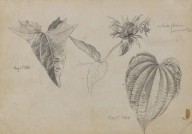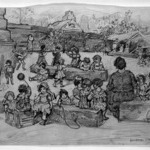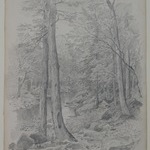
Plant Study
William Trost Richards
American Art
In their precise accuracy and close-up format, these two sheets of botanical studies exemplify William Trost Richards’s commitment to the principles of John Ruskin, an English critic who promoted a “truth to nature” approach to representation. Always a prolific draftsman, Richards here delineated the forms of various plants and wild flowers with botanical exactitude. The artist’s concern for realism based on careful observation was in keeping with the Ruskinian notion that God is manifest in the tiniest details of the natural world.
Ruskin’s ideas influenced the Pre-Raphaelite Brotherhood in England, as well as its American counterpart, the Association for the Advancement of Truth in Art, of which Richards was a member.
Ruskin’s ideas influenced the Pre-Raphaelite Brotherhood in England, as well as its American counterpart, the Association for the Advancement of Truth in Art, of which Richards was a member.
MEDIUM
Graphite on beige, moderately thick, slightly textured wove paper
DATES
August 1860
DIMENSIONS
Sheet: 5 5/8 x 8 1/16 in. (14.3 x 20.5 cm) (show scale)



SIGNATURE
Unsigned
INSCRIPTIONS
In artist's hand, in graphite: "Aug 1st 1860." at left center; "Aug 4th 1860" at lower center; and "white flower / green center" at upper right. Erased inscriptions (now illegible) at lower center and lower right.
COLLECTIONS
American Art
ACCESSION NUMBER
72.32.12
CREDIT LINE
Gift of Edith Ballinger Price
MUSEUM LOCATION
This item is not on view
CAPTION
William Trost Richards (American, 1833–1905). Plant Study, August 1860. Graphite on beige, moderately thick, slightly textured wove paper, Sheet: 5 5/8 x 8 1/16 in. (14.3 x 20.5 cm). Brooklyn Museum, Gift of Edith Ballinger Price, 72.32.12 (Photo: Brooklyn Museum, 72.32.12_PS4.jpg)
IMAGE
overall, 72.32.12_PS4.jpg. Brooklyn Museum photograph, 2011
"CUR" at the beginning of an image file name means that the image was created by a curatorial staff member. These study images may be digital point-and-shoot photographs, when we don\'t yet have high-quality studio photography, or they may be scans of older negatives, slides, or photographic prints, providing historical documentation of the object.
RIGHTS STATEMENT
No known copyright restrictions
This work may be in the public domain in the United States. Works created by United States and non-United States nationals published prior to 1923 are in the public domain, subject to the terms of any applicable treaty or agreement.
You may download and use Brooklyn Museum images of this work. Please include caption information from this page and credit the Brooklyn Museum. If you need a high resolution file, please fill out our online application form (charges apply).
The Museum does not warrant that the use of this work will not infringe on the rights of third parties, such as artists or artists' heirs holding the rights to the work. It is your responsibility to determine and satisfy copyright or other use restrictions before copying, transmitting, or making other use of protected items beyond that allowed by "fair use," as such term is understood under the United States Copyright Act.
The Brooklyn Museum makes no representations or warranties with respect to the application or terms of any international agreement governing copyright protection in the United States for works created by foreign nationals.
For further information about copyright, we recommend resources at the United States Library of Congress, Cornell University, Copyright and Cultural Institutions: Guidelines for U.S. Libraries, Archives, and Museums, and Copyright Watch.
For more information about the Museum's rights project, including how rights types are assigned, please see our blog posts on copyright.
If you have any information regarding this work and rights to it, please contact copyright@brooklynmuseum.org.
RECORD COMPLETENESS
Not every record you will find here is complete. More information is available for some works than for others, and some entries have been updated more recently. Records are frequently reviewed and revised, and we welcome any additional information you might have.




































